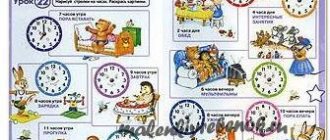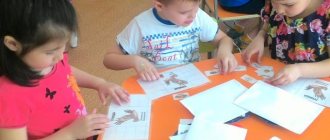Dividing a whole into parts using a piece of paper
We will need several sheets of paper and scissors.
First you need to show the child a piece of paper and explain that it is a whole object. Then you should fold the paper in half, we get half a sheet.
Having unfolded the sheet, you need to explain to the child that two halves of the sheet make up one whole sheet, and the same happens with any other object. It is necessary to show that the two halves are absolutely identical, equal parts.
Now fold the sheet in half again, that is, divide the sheet into quarters. So the child needs to be shown that four equal parts also make up one whole sheet of paper. With the help of such manipulations, a child can be taught to divide an object into equal parts, that is, in half.
Next, you should explain to the child that when dividing, equal parts are not always obtained. To do this, you need to bend a sheet of paper in an arbitrary place. But even in this case, the two resulting parts form one whole.
And only after the child has mastered dividing into parts by bending can the scissors be used. After cutting a sheet of paper in half, you need to show the child that the resulting two parts make up a whole sheet. Then you can cut these halves in half again and invite the child to make a sheet of paper from four small parts.
Then you need to take another sheet and cut it randomly into several parts. Thus, the child will see that it is possible to divide into unequal parts.
Dividing a whole into parts using a ribbon
In fact, you can use not only ribbon, but also just a paper strip. In addition, you will need toys. There must be an even number of them. These can be soft toys or dolls. The goal of the game is to divide the ribbon equally among everyone.
For example, if we have 4 dolls at our disposal, then the ribbon or strip needs to be divided into 4 parts. To do this, you need to divide the dolls first into 2 groups, and then each of the groups in half again. The ribbon is divided in the same way. So, the child will learn to divide several objects into equal parts.
You can and should consolidate the material you have covered day after day. For example, when a child helps set the table and cut the cake for tea. The acquired skills are also applicable in games. So, when playing with a construction set or putting together puzzles, you can remind your child that he is making a whole object out of small parts.
DIDACTIC GAME “ASSEMBLE A WHOLE FROM PARTS”
Goal: To train children in the ability to assemble (make a drawing) from several different parts.
Game description: Children are given cards with insects on their halves. Parts of these insects are laid out on the table. Children, when given a signal, begin to assemble images of these insects from small parts. Whoever completes the picture first receives a chip with an image of the silhouette of an insect.
DIDACTIC GAME “DISCOVER BY DESCRIPTION”
Goal: To teach children to recognize insects by verbal description.
Game description: Cards with images of insects are laid out on the table. The teacher names the external signs of any insect. Children guess the name of this insect and show the card.
ACTIVE GAME “OCCUPIATE THE HIVE”
Goal: To train children in the ability to distinguish between the lifestyles of domestic and wild bees, to teach them to act quickly and deftly.
Game description: Hoops are laid out on the floor, one less than the number of children. At the teacher’s signal, the children begin to “collect nectar”, fluttering from flower to flower. When the teacher gives the signal “occupy the beehive,” the children run to occupy a house for themselves—the “beehive.” One child is left without a home. The game continues several times.
DIDACTIC GAME “NAME IT CORRECTLY”
Goal: To train children in the ability to recognize insects by appearance and name them correctly.
Game description: The teacher prepares cards with images of insects in advance. He takes cards out of the box one by one and asks “Who is this?” To complicate the game, the teacher can ask where this insect lives, what it eats, and its method of movement.
EXERCISE “LADYBUG”
Goal: To practice the ability to act in accordance with the words in the game. Foster friendly relationships between children.
Description of the exercise: Children find panels of insects and name them. Teacher: “Who is this? (Ladybug.) What color, shape, size is it? How many specks does she have on her back?
(A lot of.)
Now let’s become ladybugs ourselves.
We circled around ourselves (circling)
and turned into ladybugs.
Ladybugs show me
Your heads, noses, mouths,
Winged arms, legs, tummies (show the named parts of the body).
The sun is shining, ladybugs are crawling on the leaves. (Children stand on all fours and crawl on the floor.)
An angry, cold wind blew and turned the bugs over. (Children roll over onto their backs and move their relaxed legs and arms.)
A kind, warm breeze blew and helped the bugs turn over.” The game is repeated several times.
DIDACTIC GAME “COLLECT INSECTS” Purpose: To consolidate knowledge that beetles and other insects cannot live in captivity.
Description of the game: The teacher notes that insects were in captivity (there was an open window in the room, a breeze blew and slammed the windows, and the insects began to panic), that they would die here, because the place of insects is in nature, what they bring to her each in their own way benefit. In turn, without insects, nature can also suffer, so insects need help.
The teacher calls several children and gives each of them a plastic bucket. To the music, children collect insect figures scattered on the floor into buckets. When the music ends, the teacher looks at how many insects the children have collected, praises them and asks them to release the insects into the wild. There are no winners in the game! The game is repeated several times, but with other children.
EXERCISE “BUTTERFLIES”
Goal: To consolidate children’s knowledge that insects have protective colors and that they choose a plant according to their color. Develop mindfulness.
Description of the exercise: Children look at the panels, determine the time of year, find butterflies. Cheerful music sounds, and the “butterflies” spin in a cheerful round dance. When the music ends, they look for their flower depicted on the floor, selecting it by color, shape, size, emotion. Tired “butterflies” “fold their wings” (put their hands behind their backs),
they sit on the flowers and freeze for a few minutes to the calm music. The game is repeated several times.
DIDACTIC GAME “PUT OUT OF STICKS”
Goal: To train children in the ability to form a butterfly silhouette from counting sticks (following the model). Develop mindfulness.
Game description: There are cards with images of insects (made from sticks) on the table. Children arrange insects in a pattern. To make it more challenging, they can stack insects as keepsakes.






